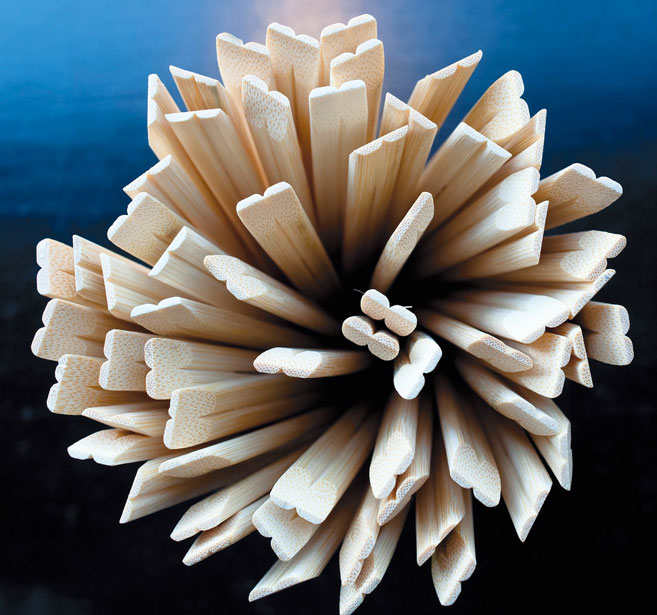Behold the Chopstick
Northern Michigan’s culinary and restaurant scenes continue to expand and incorporate globally influenced cuisines. With the recent opening of Traverse City’s first ramen shop, Gaijin, photojournalist Gary Howe takes the opportunity to explore the beauty and history of his favorite eating utensil...
The humble chopstick: simple as tools can come. Two sticks, round or squared, perhaps even triangular. Paired and properly handled they become utensils for the kitchen or the dining table. (Or possibly, as in Jackie Chan’s movie The Fearless Hyena, an instrument of close combat.) But however simple the tool, using it takes practice and muscle training. Manipulating chopsticks properly involves the use of 30 joints and 50 muscles in the hand, arm and shoulder.
Chopsticks are typically made of wood or bamboo but can also be metal or plastic. Luxury models are made of jade, bone or gold, and are common wedding or anniversary gifts for well over a quarter of the world’s population. Love poems associated with chopsticks are not uncommon. They speak to the lasting pairing and cooperation found in the best of relationships.
Our lengths are the same,
Just as the sameness of our hearts; Bitter or sweet,
We spend our life together. Having tasted it all,
We always live side by side.
One knows the other;
Our intimacy is so seamless,
No space even for a single word.
This anonymous poem was published in Chopsticks: A Cultural and Culinary History by historian Q. Edward Wong. This book takes the reader from an archaeological past, through literary references, to modern day manifestations of this simple yet versatile, tool.
We tend to forget that conveying cooked food to the mouth hasn’t always been what it is now. Early humans used their hands and rudimentary objects. The spoon gets credit as the earliest eating implement because as soon as we discovered the warmth of a cooking fire we started boiling stuff up and serving soup. The predecessors to chopsticks, invented in China 7,000 years ago, were sticks used for stirring ingredients into those early culinary delights. Chopsticks stayed married to the pot until the Han Dynasty, some 2,200 years ago.
The Han Dynasty in China was the age of Confucius, and apparently the old scholar was particularly keen about keeping the work of the kitchen separate from the dining room. Hence, during his time, the wealthy in China began to serve dishes that didn’t require cutting at the table—this quickly spread as a culinary and a social refinement. It also assisted in the rise of the chopstick in China, as the utensil was readily available to the masses and was the perfect tool for picking up Confucian-sized pieces of lamb, mutton and pig. With sticks carved by hand, and a little practice, peasant farmers could eat like the nobility. This period also explains why knives are seldom placed on the table in Chinese culture: Knives were for the domain of food preparation, not eating.
Confucius doesn’t get all the props, though. According to professor Wong, chopsticks really came into their prominence in China, and subsequently the Korean Peninsula and Japan, when wheat—and later rice—started to replace millet as the dominant grains in the waning years of the Han Dynasty, around 100 CE. Chinese meals started to move beyond soups, porridges and stews to be replaced by noodle and rice dishes, served with the now common practice of small pieces of meat and vegetables. Ten centuries later, and chopsticks were front and center in both practicality and cultural supremacy. This coincided with Chinese dumplings and noodle dishes becoming staples, something for which this author is forever grateful.
The 7,000-year history of the chopstick is still expanding. What was once limited to a small but populous corner of the world is spreading with the migration of people and food. In Traverse City, the story continues to unfold as culinary pleasure seekers now encounter the noodle, rice and dumpling dishes in more places than Chinese takeout joints. On Front Street the newly opened Gaijin serves dishes such as Miso Ramen and Niku Nuki rice bowl, dishes that somehow taste better with the use of a pair of chopsticks.
IF YOU GO:
Gaijin
136 E. Front St., Traverse City • 231-421-5466 Tuesday–Sunday 11 AM–10 PM






